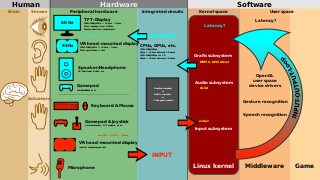The Globus Toolkit is an open-source toolkit for grid computing developed and provided by the Globus Alliance. On 25 May 2017 it was announced that the open source support for the project would be discontinued in January 2018, due to a lack of financial support for that work. The Globus service continues to be available to the research community under a freemium approach, designed to sustain the software, with most features freely available but some restricted to subscribers.

Windows Installer is a software component and application programming interface (API) of Microsoft Windows used for the installation, maintenance, and removal of software. The installation information, and optionally the files themselves, are packaged in installation packages, loosely relational databases structured as COM Structured Storages and commonly known as "MSI files", from their default filename extensions. Windows Installer contains significant changes from its predecessor, Setup API. New features include a GUI framework and automatic generation of the uninstallation sequence. Windows Installer is positioned as an alternative to stand-alone executable installer frameworks such as older versions of InstallShield and NSIS.
A job scheduler is a computer application for controlling unattended background program execution of jobs. This is commonly called batch scheduling, as execution of non-interactive jobs is often called batch processing, though traditional job and batch are distinguished and contrasted; see that page for details. Other synonyms include batch system, distributed resource management system (DRMS), distributed resource manager (DRM), and, commonly today, workload automation (WLA). The data structure of jobs to run is known as the job queue.
SQL Server Integration Services (SSIS) is a component of the Microsoft SQL Server database software that can be used to perform a broad range of data migration tasks.
Java Agent Development Framework, or JADE, is a software framework for the development of intelligent agent, implemented in Java. JADE system supports coordination between several agents FIPA and provides a standard implementation of the communication language FIPA-ACL, which facilitates the communication between agents and allows the services detection of the system. JADE was originally developed by Telecom Italia and is distributed as free software.
Service-oriented architectures (SOA) are based on the notion of software services, which are high-level software components that include web services. Implementation of an SOA requires tools as well as run-time infrastructure software. This is collectively referred to as a service-oriented architecture implementation framework or (SOAIF). The SOAIF envisions a comprehensive framework that provides all the technology that an enterprise might need to build and run an SOA. An SOAIF includes both design-time and run-time capabilities as well as all the software functionality an enterprise needs to build and operate an SOA, including service-oriented:
Windows Vista contains a range of new technologies and features that are intended to help network administrators and power users better manage their systems. Notable changes include a complete replacement of the "Windows Setup" process, completely rewritten deployment mechanisms, support for per-application Remote Desktop sessions, new diagnostic and health monitoring tools, and a range of new Group Policy settings covering many of the features new to Windows Vista.
OurGrid is an opensource grid middleware based on a peer-to-peer architecture. OurGrid was mainly developed at the Federal University of Campina Grande (Brazil), which has run an OurGrid instance named "OurGrid" since December 2004. Anyone can freely and easily join it to gain access to large amount of computational power and run parallel applications. This computational power is provided by the idle resources of all participants, and is shared in a way that makes those who contribute more get more when they need. Currently, the platform can be used to run any application whose tasks do not communicate among themselves during execution, like most simulations, data mining and searching.
Configurable Network Computing or CNC is JD Edwards's (JDE) client–server proprietary architecture and methodology that implements its highly-scalable enterprise-wide business solutions software that can run on a wide variety of hardware, operating systems (OS) and hardware platforms. Now a division of the Oracle Corporation, Oracle continues to sponsor ongoing development of the JD Edwards Enterprise Resource Planning (ERP) system. While highly flexible, the CNC architecture is proprietary and, as such, it cannot be exported to any other systems. While the CNC architecture's chief claim to fame, insulation of applications from the underlying database and operating systems, was largely superseded by modern web-based technology, nevertheless CNC technology continues to be at the heart of both JD Edwards' OneWorld and EnterpriseOne architecture and will play a significant role Oracle's developing fusion architecture initiative. While a proprietary architecture, CNC is neither an Oracle nor JDE product offering. The term CNC also refers to the systems analysts who install, maintain, manage and enhance this architecture. CNCs are also one of the three technical areas of expertise in the JD Edwards Enterprise Resource Planning ERP which include developer/report writer and functional/business analysts.
A workflow management system provides an infrastructure for the set-up, performance and monitoring of a defined sequence of tasks, arranged as a workflow application.

gLite is a middleware computer software project for grid computing used by the CERN LHC experiments and other scientific domains. It was implemented by collaborative efforts of more than 80 people in 12 different academic and industrial research centers in Europe. gLite provides a framework for building applications tapping into distributed computing and storage resources across the Internet. The gLite services were adopted by more than 250 computing centres and used by more than 15000 researchers in Europe and around the world.

The P-GRADE Grid Portal was software for web portals to manage the life-cycle of executing a parallel application in grid computing. It was developed by the Laboratory of Parallel and Distributed Systems (LPDS) at the Hungarian Academy of Sciences, Hungary.

The Grid and Cloud User Support Environment (gUSE), also known as WS-PGRADE /gUSE, is an open source science gateway framework that enables users to access grid and cloud infrastructures. gUSE is developed by the Laboratory of Parallel and Distributed Systems (LPDS) at Institute for Computer Science and Control (SZTAKI) of the Hungarian Academy of Sciences.
A scientific workflow system is a specialized form of a workflow management system designed specifically to compose and execute a series of computational or data manipulation steps, or workflow, in a scientific application.
The SHIWA is a project led by the LPDS of MTA Computer and Automation Research Institute. The project coordinator is Prof. Dr. Peter Kacsuk, it started on 1 July 2010 and lasted two years. SHIWA was supported by a Grant from the European Commission's FP7 INFRASTRUCTURES-2010-2 call under grant agreement n°261585.

DIET is a software for grid-computing. As middleware, DIET sits between the operating system and the application software. DIET was created in 2000. It was designed for high-performance computing. It is currently developed by INRIA, École Normale Supérieure de Lyon, CNRS, Claude Bernard University Lyon 1, SysFera. It is open-source software released under the CeCILL license.

Laravel is a free, open-source PHP web framework, created by Taylor Otwell and intended for the development of web applications following the model–view–controller (MVC) architectural pattern and based on Symfony. Some of the features of Laravel are a modular packaging system with a dedicated dependency manager, different ways for accessing relational databases, utilities that aid in application deployment and maintenance, and its orientation toward syntactic sugar.
JobServer is a Java-based job scheduler that started out as a simple automation engine for executing batch scripts. It supported a simple task processing oriented developer API called TaskBeans based on the Echo web application framework. JobServer gradually evolved from there and now has features that include:
Imixs Workflow is an Open-Source-Project, providing technologies for building Business Process Management solutions. The project focus on human based workflows used to execute and control workflows in organisations and enterprises. In difference to task-oriented workflow engines, which focus on automated program flow control (tasks), Imixs Workflow is a representative of an event-based workflow engine. Here, the engine controls the status of a process instance within a defined state-diagram. By entering an event, the state of a process instance can be abandoned or changed. In human-centric workflow engines, events usually occur by an interaction of the actor with the system, for example by approving or rejecting a business transaction. They can also be triggered by scheduled events. An example of this is an escalation of an unfinished task.
An application strings manager is a software tool primarily designed to optimize the download and storage of strings files used and produced in software development. It centralizes the management of all the product strings generated and used by an organization to overcome the complexity arising from the diversity of strings types, and their position in the overall content workflow.










